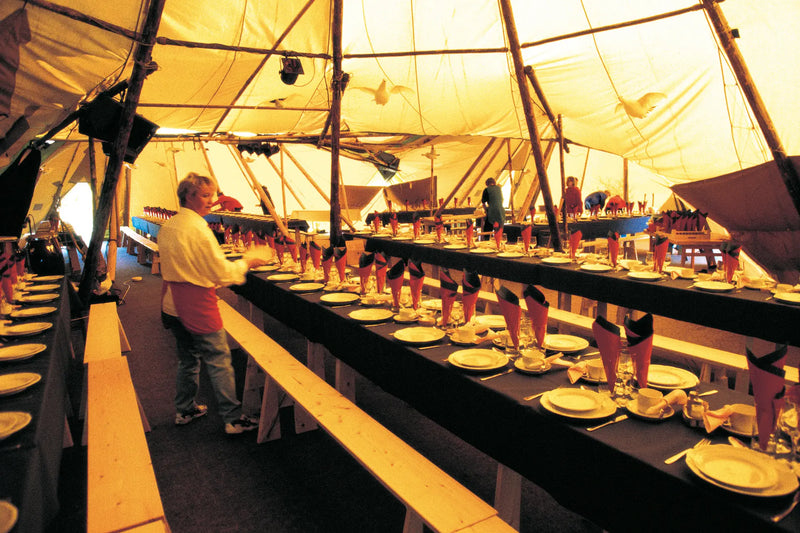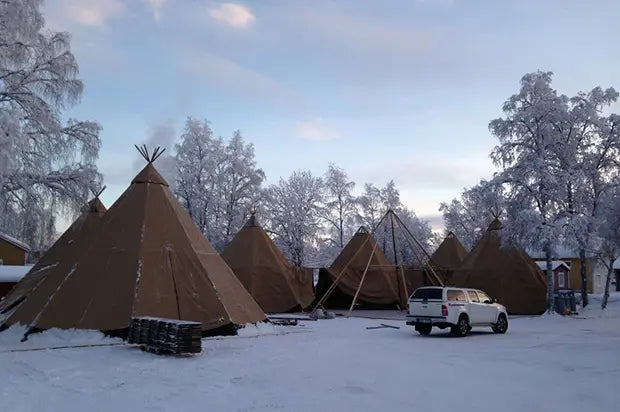One of the really great features of Tentipi’s giant tent, the Stratus 72, is its abilities to be linked together. You can add two, three, five, or an infinite number to create huge enclosed spaces that can host weddings, business events and festivals. Tentipi’s founder and CEO Bengt Grahn even says this feature is one of the very key reasons for the company’s success in the event tent industry. But the invention actually came from one of our earliest customers – a Sami guy called Roger Rimpi from Jokkmokk, northern Sweden.
"I got a call from a museum in Stockholm, they were planning a jazz festival and wanted a traditional Sami tent for 250 people. It was my biggest job offer so far, so of course I said yes!" says Roger Rimpi.
"As soon as I hung up my colleague asked me how in the world we would solve this, our Stratus only fit 72 people!"

New tent on the market
This was back in 1993, Tentipi was only four years old and still going under the name “Moskoselkåtan” (Moskosel being the village where the founder, Bengt Grahn, started the company). The Stratus was a brand new tent on the market, a giant event tent version of its smaller camping tent predecessors. Roger had started his own company Samelandsresor in 1990, renting out snowmobiles and hosting ski-doo safaris, and like many people in his area he was looking for another leg to stand on for his business.
"Jokkmokk municipality is 19 000 square kilometres big but only about 5 000 people live here, so you cannot live from simply doing one thing, there are just not enough people", Roger tells.
"Also, being a Sami it’s in my culture to have many skills. Back in the day, in these scarcely populated areas you couldn’t rely on reindeer herding or fishing alone, you needed to know a little about everything to make your living. And Roger’s heritage is integral with his impact on Tentipi history.

The cone shaped tents exist in almost every indigenous culture in the world, so it’s a well-tested construction
Roger Rimpi

Needed a “Sami-looking” tent
The Sami are the indigenous people of northern Scandinavia and Russia and their traditional houses, called “lávvu”, “kota”, “kåta”, and other variations depending on the language, are the inspirational source of Tentipi’s Nordic tipis. For Roger, coming from a Sami family, it was natural to use Sami tents as part of his event business.
"First we did it the old-school way, collecting branches out in nature and building them on site, stitching the canvas etcetera, but it wasn’t practical as the business grew."
So Roger looked for other solutions. Tentipi’s Adventure tents became his choice for camping with tourists on his snowmobile safaris.
"I cannot speak for other Sami, but for me, I think it’s great that there is a product out there based on the same principles as the Sami tents. I mean, the cone shaped tents exist in almost every indigenous culture in the world, so it’s a well-tested construction."
But except for the cone shape and the ability to keep an open fire inside the tent, Roger is clear to point out that the products Tentipi make and the traditional houses of the Sami are two separate things.
"It’s not the same thing! A traditional Sami lávvu is made from what you find in the forest. And every lávvu is unique, custom made to the needs of the person who use it – a tall person builds a higher tent than a smaller person, for example. Tents from Tentipi use modern materials and come in pre-defined sizes."


Buying tarps at the gas station
For Roger’s business, the portable, easy-pitched Nordic tipis from Tentipi was a great alternative to the traditional lávvus, both aesthetically and practically. Soon he discovered that Tentipi also made event tents and bought his first Stratus 72. That’s about when he got the phone call from Stockholm, 1 034 km south from Jokkmokk.
"After we hung up I called Bengt at Tentipi and asked him if I could rent two Stratus 72, as I only had one. By then Tentipi had no rental in-house, but I managed to talk him into renting out two tents."
Arriving with three Stratus 72 and nothing more in Stockholm, Roger and his colleague Richard started building the tents in a triang
"We had no exact idea of how this would be done. When all was built I told Richard to go to the gas station and buy as many tarps and straps he could find."Using plastic tarps they covered the open spot in the middle where the brims of the Stratus didn’t reach, patching together a construction that fit 250 people, a stage and a jazz band.
"We were super proud of what we had done, and the customer was very happy too!"
Soon, customers started asking for covers and accessories to make the connection easier and more beautiful. Today, these products are part of our standard offering. They are a big reason for the success of the Stratus 72 and a crucial feature for anyone who wants to create great events
Bengt Grahn

New technique a success
Later Roger got a call from Vattenfall, a major electrical power company in Sweden, asking if he could build tents to host 250 guests at an anniversary in Porjus, north of Jokkmokk.
"This time I bought the tents and also some extra canvas so I wouldn’t have to use plastic tarps. I also invited Bengt Grahn to come along to see what I was doing."
"I remember especially when Bengt told me about how he imagined of the assembly before he actually saw it – a lot of wooden poles that crossed each other and were in the way of the guests. But when he saw it in reality he was very surprised that it looked so nice, almost as it was supposed to be built like this from the beginning", Roger says.
"Amazing! was my first thought when I saw what Roger was doing", Bengt recalls.
He took photos of Rogers’ creation and added it to the product catalogue of the coming year as an example of what customers could do with the tent.
"Soon customers were asking for panels and accessories to make the linking easier and nicer looking. Today these products are part of our standard assortment. They’re a major reason for the success of the Stratus 72 and a crucial feature for anyone who wants to create fantastic events", Bengt tells.
"For me, it became a competition with myself. If I could link together three tents, could I do four? And five… Today I see Tentipi rentals all over the world doing amazing builds with fifteen, twenty linked Stratus 72. It’s great to be part of that development", Roger concludes.
(Roger Rimpi and Samelandsresor have been retailing and renting Tentipi products for over 25 years in the north of Sweden and are also the distributors of Tentipi products across the border, in Finland.)










